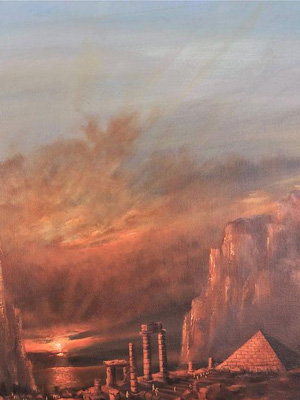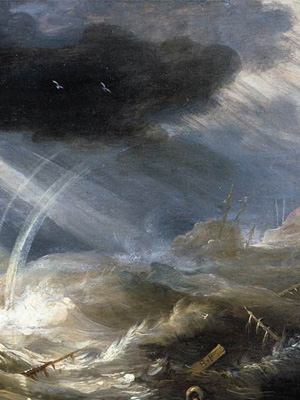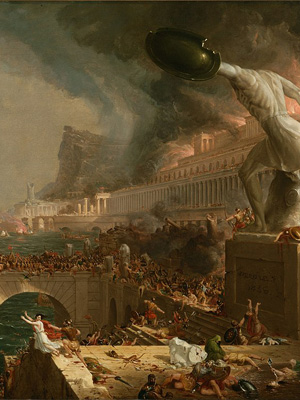Masonic Articles and Essays
The Myth and Reality of Atlantis
Exc... Bro... Aksel Suvari 18o
Date Published:
8/28/2024
The myth of Atlantis has persisted throughout time as one of the most powerful collective memories of mankind. But could there be some truth to this undying story? What can this legend teach the Freemason of today?
 The idea of Atlantis is a concept that dwells deep within the imagination of every human culture on the planet. Perhaps the name is different from place to place but almost all religious and mythological traditions point backwards in time to a “Golden Age”. From the 1st, 2nd and 3rd Suns of the Hopi Legends to the Yugas of Hindu cosmology and the legend of the Garden of Eden, a recurring theme in human mythology is that of a time before the fall of Man when civilization was more advanced, morality more perfect and life in general was more harmonious. Freemasonry too looks back to the time of the building of King Solomon’s Temple with reverence and points out to us today the qualities that the architects of that edifice possessed that humanity seems to have lost today.
The idea of Atlantis is a concept that dwells deep within the imagination of every human culture on the planet. Perhaps the name is different from place to place but almost all religious and mythological traditions point backwards in time to a “Golden Age”. From the 1st, 2nd and 3rd Suns of the Hopi Legends to the Yugas of Hindu cosmology and the legend of the Garden of Eden, a recurring theme in human mythology is that of a time before the fall of Man when civilization was more advanced, morality more perfect and life in general was more harmonious. Freemasonry too looks back to the time of the building of King Solomon’s Temple with reverence and points out to us today the qualities that the architects of that edifice possessed that humanity seems to have lost today.
The primary source of evidence about Atlantis comes down to us today from the writings of Plato, one of the most eminent Greek philosophers of antiquity and the man from whom much of Western civilization has sprung. There are two documents, the Timaeus and the Critias, in which references to Atlantis are given by Plato as accounts of dialogues that Socrates had with two Grecian men. Both of these accounts are in the form of stories told to Socrates of the exploits of the ancient Greek poet and statesman Solon and of what he learned on his travels throughout Egypt. Upon arriving in the Egyptian city of Sais Solon made his way to the local temple and there encountered an inscription upon the temple’s pillars that mystified him. When he asked the priests of the temple to explain the story written on the pillars they told him that 9,000 years before his visit (approximately 11,500 years before the present) there had existed an island continent “west of the Pillars of Herakles” (the Strait of Gibraltar – opening of the Mediterranean sea) that had been destroyed by a cataclysm after losing a great war of conquest.
The Egyptian priest told Solon that Atlantis had once been ruled over by the god Poseidon and that it was this deity who was responsible for implanting humanity in this area by “consorting” with a mortal woman and endowing her children with extraordinary traits and abilities. It was these descendants that were given the right to rule over Atlantis, a land that was highly technologically developed. Ancient Atlantis was apparently capable of great earth works and construction projects, building a series of concentric islands with lochs and bridges that allowed ships to sail from the open ocean to the heart of the capital city. Atlantis boasted glorious temples, advanced systems of agriculture and commerce and the ability to navigate the ocean, wage war and conquer other lands, all about 7,000 yeas before it is commonly supposed that civilization began. Atlantis and its rulers, according to the account of Solon, began to fall into moral decay as they became more and more entangled with mortal affairs and disregarded or rejected their divine origins and heritage. The Atlantean civilization launched a war of conquest against her neighbors, aiming to subjugate the world, it was only the valiant efforts of the Athenians and their patron goddess that turned back the enslaving Atlanteans and liberated the Mediterranean world. After this great war a great catastrophe befell the Atlantean continent and utterly destroyed it, possibly sent by the gods of Olympus, though the account of the actions of Zeus is cut short by the fact that the majority of the Critias has been lost to history.
Commonly associated with the legends of a Golden Age or a lost civilation are the myths of a great flood that brought about its destruction. Across human cultures we find example after example of this idea and each flood myth, no matter how distant from any other myth by time or geography, all share several key elements that point to a single source for the story. A heroic, noble or holy person is selected by the gods (or God, though the plural is more common for reasons we will explore later) and warned of the impending disaster. This disaster is always described as being caused by the moral degeneration of the earth with human beings responsible in one way or another. He is told to build and often given the knowledge or plans to build some sort of life preserving structure that represents the highest technology of the hero’s society, whether this is an ark, fortress or underground vault. The hero is told to gather as much biological material for the preservation of life as possible and shelter it in his ark, along with an extended family for the purposes of repopulation. After the calamity subsides, the hero emerges to rebuild civilization and his descendants often go on to be the rulers of the newly established societies. Below are several examples of this myth from across the world.
 Noah’s flood – Noah is forewarned by God (technically the plural Elohim) that a deluge is coming, told to build ark, preserves life and when the flood subsides restarts civilization from the contents of his ark
Noah’s flood – Noah is forewarned by God (technically the plural Elohim) that a deluge is coming, told to build ark, preserves life and when the flood subsides restarts civilization from the contents of his ark
Epic of Gilgamesh – Utnapishtim is informed that the gods plan to flood the world and destroy wicked mankind. He is told to build an ark, preserve all life, and restores civilization after the flood subsides, whereupon he is rewarded with immortality
Hopi Legends – Spider Grandmother shelters the Hopi in bamboo tubes and buries them underground. When flood subsides Spider Grandmother opens shaft to the surface and builds boats for the Hopi and guides them to shores of the 4th world. Civilization is restarted.
Shraddhadeva Manu – Forewarned by Vishnu of an impending flood, builds an ark, preserves life and brings along seven sages to rebuild civilization after the flood survives
Deucalion – Greeks had begun to engage in human sacrifice which angered Zeus to the point of destroying the world. Deucalion was forewarned, built an ark, preserved life and restarted civilization with his family after the flood
Lamech – A character of Biblical and Masonic legend, Lamech constructed two pillars in a nine layer underground vault, sealed against catastrophe by fire and water and from them the ancient arts of freemasonry and civilization were reconstructed after the deluge.
For many centuries the legend of Atlantis was considered to be just that, a legend. Treasure hunters and glory seekers have for many years attempted to locate the fabled lost continent but to no avail. Many Freemasons have investigated the legitimacy of the Atlantean legend and have come to many diverse conclusions. One modern Masonic researcher, Randall Carlson, has proposed a plausible scientific explanation as to how an Atlantic continent could have existed and, more importantly, could have vanished beneath the waves.
Randall Carlson is a geologist, geometer, architect and 32nd degree Freemason who has been studying earth science, sacred geometry and Ice Age geology since 1969. His hypothesis as to the existence of Atlantis is intriguing and lines up with dates given by Plato in his Socratic dialogues. It is the hypothesis of Carlson and other scientists that at the end of the Younger Dryas period a comet or series of comets impacted the Earth and liquified the one to two mile thick sheet of glacial ice that covered the north pole of our globe as far down as Minnesota. This impact could be responsible for the event that we now know as the Flood of Noah. Carlson proposes that had a continent-sized land mass been present in the middle of what we now call the Atlantic Ocean, which would have been likely due to the reduced sea level of the globe during a period of a massive polar ice sheet, the fluctuations of the Earth during the impact of the comet along the Mid-Atlantic ridge could have caused a massive catastrophe for any landmass sitting on top of that tectonic divide.
As we saw earlier from our examination of the flood myths there are two elements of this common legend that should be of unique relevance to Freemasonry: a plurality of gods and the rebuilding of civilization. Anatomically modern humans, human beings with brains the same size as ours, have existed on this planet for at least 200,000 years. Often we forget that our ancestors were also humans just like us, capable of abstract, conceptual thinking and complex, historical storytelling and we tend to oversimplify already difficult to interpret myths and legends. In almost all Flood myths the “gods” do not seem like gods at all but rather groups of technologically advanced beings who share devices or methods and techniques with their less developed neighbors, just as we may seem to remote, uncontacted populations that still live at a Stone Age level of development today.
These images are taken from three distinct cultures, though many more exist, and depict what we now call gods. These so called “gods” are all credited by their respective cultures as having restored civilization after a disaster and have been adopted as the patron saints of the cultural arts of their societies. Interestingly enough, each of them carries or wears an indication of technological rather than divine origin.
From the Babylonian Apkallu or “Wise Sages” to Quetzalcoatl of the Aztecs and Dagon of the Assyrians, these gods came from elsewhere on Earth, not “the heavens”, and rebuilt civilization from the Stone Age level inhabitants of a post-catastrophe world. They did this, according to legend, in two ways – the establishment of agriculture and the creation of religions, priesthoods and temples. Freemasonry itself can be linked back to these very same origins as being the ritualistic practice established after the Flood, the preservation of the knowledge that was mostly lost to the world after the destruction of the previous civilization.
In many ways it can be said that modern civilization is approaching the stature of ancient Atlantis, if we take the myth to be at least somewhat true. We have developed magical technologies. The globe is covered in a near instantaneous network of communication that allows all people to communicate with one another. We can travel great distances in very short periods of time and in many places the material needs of life are supplied in abundance. But while these great developments have increased the global quality of life they have also amplified the both the lofty and petty nature within human beings. Technologies that have the power to feed, clothe, and care for the unfortunate of the world have also been turned into forces of destruction that have created untold misery in our world. Though history has progressed and the shape of the face of the Earth has changed, the essential human struggle has remained the same.
 Far from being only cautionary myths alone, I believe that the tales of the downfall of Atlantis are ancient historical examples of the consequences of societies abandoning their morality in favor of the accumulation of worldly power. Whether due to outright conflict or by inattention to natural cycles and events that results from the quest for power, when a civilization abandons the principles of Natural Law its demise is assured. Freemasonry has always recognized this fact of history, that the well-being of civilization is dependent on the preservation of morality in the structure of that society and that should civilization’s light be dimmed by disaster only those committed to the study of Nature and the service of mankind would be able to restore humanity to its former glory. Without the compass of Nature to guide our steps, humanity risks destruction at the hand of the very same forces that can give us life. Freemasonry teaches us to always make the natural world our guide and to emulate at all times the divine principles gleaned from the study of Nature, for if we abandon nature, we abandon ourselves to our own destruction.
Far from being only cautionary myths alone, I believe that the tales of the downfall of Atlantis are ancient historical examples of the consequences of societies abandoning their morality in favor of the accumulation of worldly power. Whether due to outright conflict or by inattention to natural cycles and events that results from the quest for power, when a civilization abandons the principles of Natural Law its demise is assured. Freemasonry has always recognized this fact of history, that the well-being of civilization is dependent on the preservation of morality in the structure of that society and that should civilization’s light be dimmed by disaster only those committed to the study of Nature and the service of mankind would be able to restore humanity to its former glory. Without the compass of Nature to guide our steps, humanity risks destruction at the hand of the very same forces that can give us life. Freemasonry teaches us to always make the natural world our guide and to emulate at all times the divine principles gleaned from the study of Nature, for if we abandon nature, we abandon ourselves to our own destruction.
More Masonic Articles
Explore articles and essays written by Freemasons about Freemasonry.
Read More
Membership
Interested in becoming a member of the worlds oldest Fraternal organization?
Read More